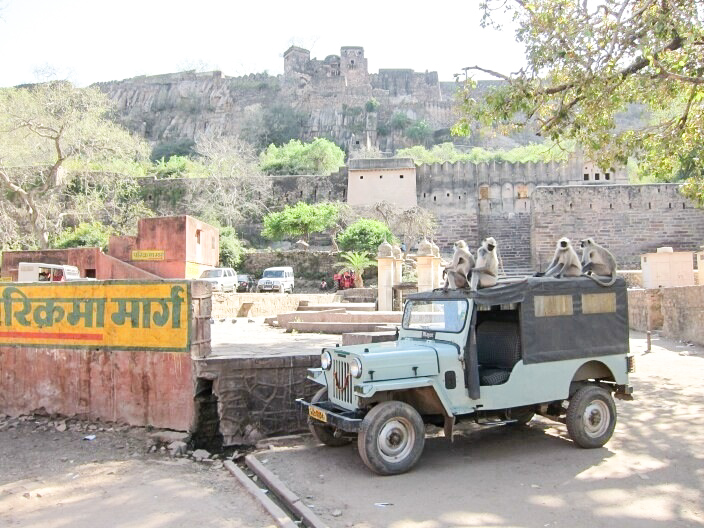Our first stop in India’s heralded Rajasthan state was historic Ranthambore National Park.
From Fatehpur Sikri, we took a five-hour train ride to Sawai Madhopur, the nearest city to the park. As we headed west, the scenery turned increasingly rural with arid plains interspersed with low hills and plateaus.
Arriving after dark, we checked into Hotel Mountain View, a modest guesthouse (that’s since been updated). We ordered dinner and weary from the travels, promptly fell asleep.
The following morning, we enjoyed a leisurely breakfast on our back patio: scrambled eggs with vegetables that were bursting with flavor. It’s amazing how fresh and cheap the food was at all the Indian guesthouses where we stayed.
Before venturing to the park, we took a brief stroll around our guesthouse. We quickly realized there was not much to see beyond a worn “Crafts Village” building, a vibrant cargo van, and a sign in squiggly language. Clearly, tourists came to this location for the park only.
Our tuk tuk driver from the night before picked us up and drove us to Ranthambore National Park.
The park is considered one of the most famous national parks in Northern India, as well as one of the largest. Originally established as Sawai Madhopur Game Sanctuary in 1955, it served as the former hunting grounds of the Maharajas of Jaipur –our next destination.
After buying tickets, we climbed into a safari bus called a “canter,” an open-air jeep that seats up to 20 people. Luckily, we had about half that many people – all Indian tourists, mostly families with kids.
Our driver reminded us of the Bedouin guides from our camel trek in the Sahara Desert. He looked quite regal wearing a scarf wrapped around his head. He greeted us with a warm welcome, clearly in his element.
Once our motley crew was settled, we headed out for our adventure. The forts, palaces and ruins inside the park created an interesting juxtaposition to the wilderness. At Naulakha Gate, a group of Gray Langur monkeys greeted us, casually perched on a parked jeep. They seemed unfazed by our presence.
Driving through the park, the landscape unfolded into a mix of stark bushland and grassy meadows.
One of our first wildlife sightings was the Rufous Treepie, a striking yellow bird with a black head and distinct white stripe. Further on, we paused to watch a herd of Sambar deer, India’s largest deer species, graze peacefully in a pasture.
Continuing on, we encountered a group of peacocks crossing the road – a.k.a. a “muster.” Seeing these iconic blue peacocks in their natural habitat was remarkable. In a way, they almost seemed too regal for the jungle. Instead, it was easy to envision these majestic creatures wandering places like the “Palace of Winds” in Jaipur back in the heyday of the maharajas.
Next, we came across an area filled with banyan trees. These trees are considered sacred in India with rich historical and spiritual ties, as well as medicinal properties. Incidentally, the largest Banyan tree of India is located behind the Jogi Mahal, the hunting lodge in Ranthambore National Park.
We then came upon an area with hoards of Langur monkeys – called a “troop.” As we watched them scamper about, one brazenly jumped onto the side of our jeep. Inches away, our driver instructed us to remain calm. The intruder surveyed the scene, circled the jeep, and eventually left out of boredom.
Just then, a radio dispatch informed our driver of a Bengal tiger sighting.
The driver put the jeep in reverse and off we went, bumping along the dirt path. The excitement was palpable – that is, until we reached the spot. There, in the middle of nowhere, among incredible nature and wildlife, about a dozen other gas-guzzling safari jeeps with hundreds of eager tourists had shown up as well. The scene was comedic and just about as inauthentic as you can get.
In the end, the elusive Bengal tiger remained elusive for us. As the sun began to set, the beauty of the natural world came into focus. Not even the cluster of jeeps could obscure the breathtaking sight: a sky painted in a myriad of colors that made us forget the earlier commotion.
In that moment, we felt a profound connection with the authentic wonders of Ranthambore National Park. And so we concluded our day, content with the real beauty that nature had gifted us.

